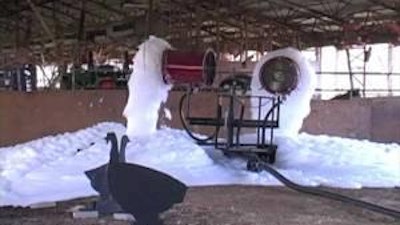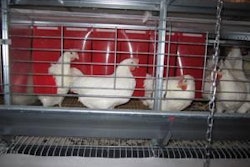
Avian influenza continues to be a topic for discussion and research because outbreaks in poultry can cause high losses in poultry, pose a threat to human health and adversely impact the international trade of poultry products.
Most strains of the avian influenza virus are considered to be of low pathogenicity. However, the H5 and H7 strains are of particular interest since these strains have been responsible historically for highly pathogenic outbreaks in commercial poultry. The “bird flu” that has been in the news is the Asian strain of an H5N1 avian influenza, and the disease persists as a problem with 49 human cases as of November 2011. The economics associated with controlling these outbreaks can cost millions of dollars with huge losses of birds.
Research concerning numerous diseases was presented at the 2011 meeting of the Poultry Science Association and the American Association of Avian Pathologists. Some of the diseases discussed included Runting Stunting Syndrome, Marek’s disease, infectious bursal disease, avian influenza and coccidiosis. Avian influenza, however, was the subject of numerous reports and the focus of two sessions at the meeting.
Surveillance shows AI prevalence, antibodies
The AI virus is known to be in wild birds. In fact, the natural reservoir of the virus is waterfowl and various species of shorebirds. The virus is also known to readily mutate. These two factors make surveillance efforts in waterfowl migratory flyways and in domestic poultry critical in establishing what strains are present in the natural reservoir.
A research report by B. Lupiani of Texas A&M University presented data from a multi-year study of avian influenza in the Central Flyway. Over 7,000 cloacal swab samples were collected and tested for AI. The majority of the samples collected (over 85%) were from dabbling type ducks. The samples were tested using RT-PCR testing and all positive samples were processed for virus isolation. A total of 607 samples were positive on the RT-PCR test and of those 155 AI viruses were isolated. The most common subtypes isolated were H3N8 and H4N6. This research in birds in an understudied flyway showed that during the five years of the study no H5 or H7 strains were identified in 7,478 cloacal swabs tested.
Surveillance efforts in domestic poultry populations in understudied areas can also be useful in tracking exposure of birds to AI. The results of a surveillance study in chickens, ducks, pigeons and other species in Grenada were presented by R. Sharma of St. George’s University. Blood samples and cloacal and tracheal swabs were collected for testing from small flocks. A total of 230 blood samples and 230 mixed tracheal and cloacal swabs were collected. The majority of the samples collected (143) were from backyard chickens. No avian influenza RT-PCR positive samples were found and no AI viruses were isolated. However, 27 blood samples from backyard chickens were positive for AI antibodies.
This study indicates that while no AI viruses were isolated from tested small flocks and no outbreaks had occurred in 2009-10, antibodies were present.
Virus receptors give clues about transmission between species
Research by M. França of the University of Georgia should be of value in understanding the transmission of AI between species. AI viruses bind to specifically linked receptors on cells as part of virus entry into the cell, and these linkages are different for avian and human influenza viruses.
França presented results of a study looking at the prevalence of two Influenza A virus receptors in tissues. Various wild bird species from nine different orders of birds were tested for the two receptors. The results of the study suggest varying expression of the two receptors among the wild birds tested. In addition, various species expressed human-type receptors, suggesting the ability to bind human influenza type viruses. The result of this research adds to the knowledge and understanding of the different receptors present on cells for AI viruses to bind to before entering a cell.
Increased understanding of AI pathogenicity
Avian influenza varies in pathogenicty. Low pathogenic strains can cause mild, if any, clinical signs or mortality. High pathogenic strains of AI are capable of causing severe clinical signs and extremely high mortality. The H5N1 highly-pathogenic AI has been reported to have increasing virulence in ducks.
M. Pantin-Jackwood, from the Southeast Poultry Research Laboratory reported on a research study addressing the pathogenicity of the highly-pathogenic H5N1 AI virus in domestic ducks. The study examined the virulence of single-gene reassortants in an effort to determine which viral genes contribute to increased pathogenicity.
Reverse genetics was used to produce the single-gene reassortant virus from two Egyptian H5N1 AI viruses that had shown different pathogenicity. One of these AI viruses was highly virulent in ducks and the other was less virulent in ducks.
The single-gene reassortant viruses produced were inoculated into two-week-old Pekin ducks. The ducks exhibited more severe clinical signs than the less virulent parent but not the high mortality of the highly-virulent parent virus.
The results indicated that more than one gene is involved in the pathogenicity of the Egyptian H5N1 AI virus. Increased understanding of the genes of the AI virus is of tremendous benefit in understanding the effects of genetic mutations and how these changes can impact the host range and virulence of the virus.
Vaccine research shows promise
Many infectious diseases of poultry have been dramatically reduced by the use of vaccination programs. Prevention and control of avian influenza requires a multifaceted program, but vaccination has been used and can be used as one tool in that program. Research into use of various AI vaccine delivery systems and variants continues to enhance methodologies for controlling and/or preventing outbreaks of avian influenza.
Virosomes are a method of delivering a vaccine. They consist of a phospholipid bilayer vesicle and viral-derived protein. Virosomes are not able to replicate but are capable of fusing with the target cells. They have been used in humans as a vaccination method for influenza but have not been used as a vaccination method for poultry.
S. Sharif of the University of Guelph reported on avian influenza virosome-based vaccine research in poultry. The project involved infecting chickens with an H4H6 AI virus then vaccinating them with a virosome-based vaccine. The virosome-based vaccine was used alone or in combination with interferon-gamma or synthetic DNA CpG ODN expressed by a recombinant baculovirus. The vaccinated birds all seroconverted; the highest antibody titers were observed in those birds vaccinated with the virosome-based vaccine and the CpG ODN.
Sharif’s research demonstrated that virosome-based vaccines against AI would immunize chickens and if the vaccine also contained CpG ODN the immune response would be enhanced. This is an important finding since a virosome-based vaccine would allow vaccination without the possibility of viral replication and subsequent spread.
Vaccine delivery methods
Vaccination of poultry can be accomplished by many methods. However, a delivery method where vaccine could be given to large numbers of birds would save in labor costs and be another tool for the control of AI.
J. Earnest of the University of Georgia reported on a vaccine delivery method for AI vaccine that would not be labor intensive. This research assessed the use of an aerosol vaccine for Influenza A. The vaccine contained virus-like particles which had been produced by baculovirus that was grown in insect cell cultures.
Virus-like particle vaccines have been used in humans and mice and have been shown to be highly immunogenic. These particles contain viral proteins but no genetic material hence they cannot replicate. However, they have not been administered via aerosol delivery.
In Earnest’s study, one-day-old chickens were aerosol vaccinated twice with a vaccine containing virus-like particles. Serum samples were collected from the birds and tested for antibodies. The birds vaccinated by aerosol delivery were positive for antibodies.
The results show that non-replicating proteins of the AI virus could be used successfully to vaccinate birds via aerosol. This research has application in the commercial industry in that aerosol delivery could be a method of vaccinating large groups and/or numbers of chickens for AI.
Additional research needed
Avian influenza continues to be a threat to the poultry industry, and research efforts aimed at surveillance, better understanding the virus and vaccination possibilities assist in the control and/or prevention of the disease.
While biosecurity is a key component to prevent entry of avian influenza into commercial poultry flocks, research has the potential to produce new tools for control strategies.

















